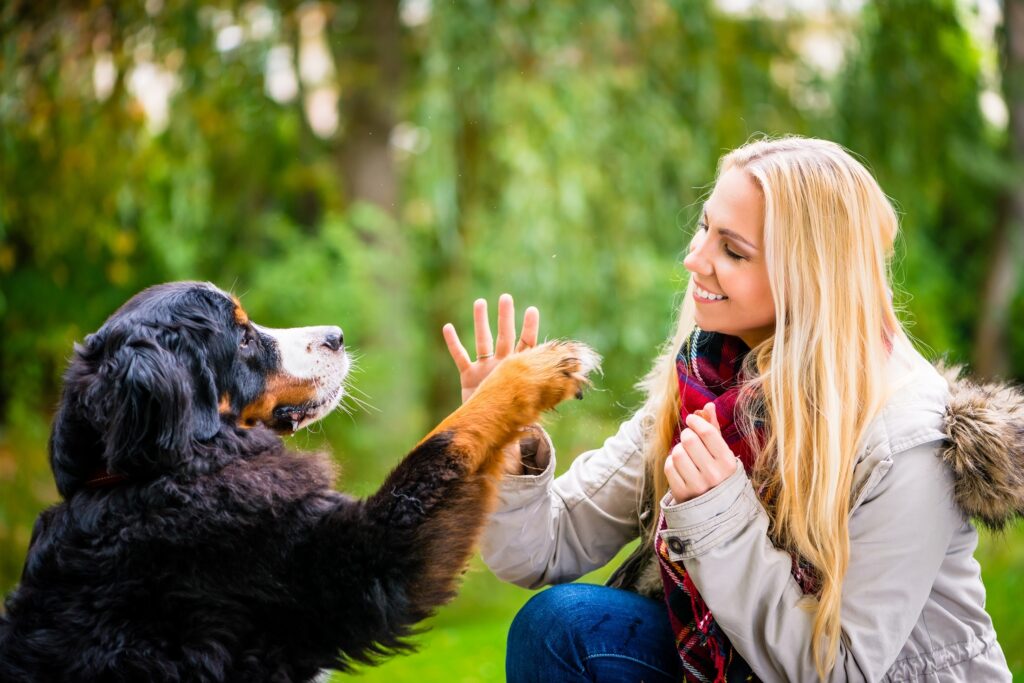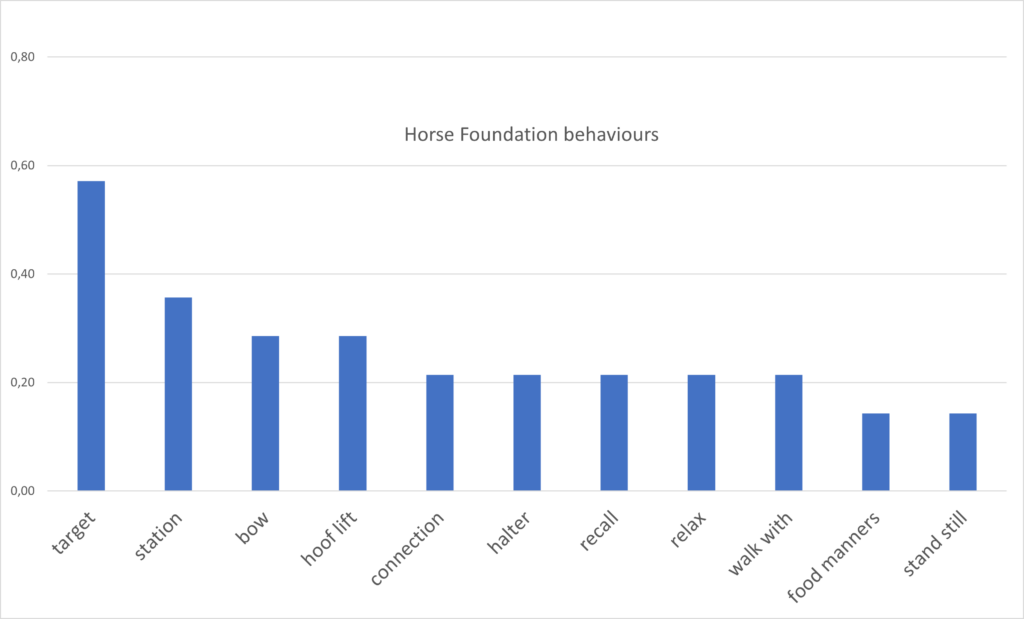I’ve recently revised my introductory animal training course, and one thing we do in the course is discuss which behaviours to start teaching an animal.
The 6 foundation behaviours.
Not only are these the behaviours that the animal learns first, so they are the ones that he’ll tend to revert back to and offer when he doesn’t know what else to do, but they also teach him about this game we’re playing together.
The foundation behaviours teach the animal what training is all about.
That it’s fun.

That the trainer is a good person to be around – interesting things happen next to that person, which builds their relationship.
That “if I do this, that happens”. He learns that his behaviours have outcomes, that he can make things happen in the environment.
He learns that he has control.
Oh, and by the way, this is one reason why training is so important: control improves welfare. Training isn’t about teaching the animal cute tricks (as we will see in a minute), but rather, it’s a way of giving control to the animal, improving his welfare, and giving him the opportunity to be an eager and active participant in his own care.
When done right, these first training experiences can have massive impact on the animal’s confidence and behaviour – not to mention the quality of his relationship to humans.
Anyway, when doing that course revision, it occurred to me that it would be interesting to see which foundation behaviours other people train their animals, and whether it would be different for different species. So I polled my Facebook crowd, and my email list. And I didn’t specifically ask about the first behaviours people would teach, but rather, if they had to settle for only 6 behaviours altogether – which would those be?
74 dog people replied, and 14 horse people. So, this is a small sample, which includes both pet owners and professionals working with animals.
And, without further ado, here’s what my crowd of people would teach their animals.
Dog Foundation Behaviours
The most common behaviour to train with dogs was a recall, a whooping 80% would include this as one of the 6 most important behaviours they would train.

The second most common behaviour was some version of “impulse control”, including disengagement, leave it (nicely reframed by Sarah Owings from focusing on the animal behaving well to the trainer teaching stimulus control in this blog post), and look-at-that.
People also prioritized loose leash walking, or staying next to the person without a leash, followed by some version of stationing (staying in place, on a mat, bed or in a crate).
I found it interesting that 1/3 of people who discussed handling mentioned that they would use some type of explicit consent, such as a start button behaviour; their animal having a way of agreeing to the handling – or not agreeing to it.
Note that none of the behaviours that at least 5% of the dog people mentioned would be characterized as teaching “tricks”. Rather, they’re all behaviours that somehow makes it easier for the animal to live with humans.
Among the behaviours chosen by less than 5% of the dog people, we found, to mention a few, on-off cues, pressure release, “all done”, trade, fetch, responding to one’s name, mands and emergency recalls.
Horse Foundation Behaviours
57% of the horse people who answered the poll would teach them a targeting behaviour (touching something with some part of their body) – note that the dog people also mentioned targeting, but not to the same extent. And the most important dog behaviour, the recall, is only on the top-6 list for 20% of the horse people.

In other words, the list of Foundation Behaviours is going to differ between different species, because they live in completely different contexts.
Dogs are often with us in public spaces, sometimes off leash, and having a solid recall is vital. That’s typically not an issue with a horse, for them controlling their movement is a higher priority since they’re so large and potentially dangerous.
Indeed, stationing can be considered a type of targeting: moving to a specific location or a specific stimulus.
Bowing (the lowering of the head) is considered to be calming for horses; hoof lifting is the most common type of hands-on handling that’s needed. Notably, one person who trains her horses for haltering explicitly called it self-haltering (so the horse is actively pushing into the halter rather than passively accepting to have it put on). Love that tweak; gives the animal control!
The graphs show that there’s more variability in the horse community about what’s considered important, compared to the dog community. It might be because the sample size is much smaller and therefore less robust, but it might also be that since horses typically don’t live with us humans 24-7, what we choose to teach them is more a matter of interest rather than dictated by living conditions.
Interestingly, more horse people explicitly mentioned the importance of the horse-human connection. I don’t think this means that dog people don’t care about their connection to the animal, rather I’m guessing that most dog trainers take it for granted. The horse trainers who took this poll, and who I’m assuming are all positive reinforcement trainers, have probably transitioned from training with negative reinforcement, and as crossover trainers they’re more likely actively rethinking their human-animal bond. In my experience, there are more crossover trainers (or more recent crossovers) in the horse training community than the dog training community, as compared to trainers who’ve trained only using positive reinforcement.
More uncommon behaviours that people would train their horses were “all done”, pressure release, side passes, and sitting (!), to mention a few.
Anywhoo, those were some of my reflections when looking at this small data set. What are your first thoughts when looking at the graphs?
Thank you everyone who participated in this little poll, I really appreciate your playing along, and got some great insights – for example the value of teaching an emergency recall in addition to an “ordinary” recall! I also have one mouse, one boa, five cats, one parrot, and one tortoise on the list, but I would like more data (say, at least 10 people per species) to do any meaningful analysis on those species. So, if you want to add data to my collection, please let me know below which 6 behaviours you could choose to train if you had to limit yourself – and don’t forget to mention the species! I’ll be sure to update this post to include an analysis of “your” species once I reach that threshold of 10 votes!
I write the occasional blog posts, do silly experiments and polls such as this one, I offer free mini-courses and masterclasses, as well as massive online courses about animal behaviour, learning and welfare. Sign up below, and I’ll keep you posted on any such future event!
10 replies on “The 6 foundation behaviours”
My top 6 priorities (rather than behaviors) would be: feeling calm and confident in all environments, stationing, value is staying close to and focused on me and ability to disengagement from distractions.
Thanks Suzanne! You can build a lot from that, for sure! 🙂
Hi Debbie. Not on my list, because ‘toileting’ are behaviours they already know how to do. All we need to do, is to facilitate for them so that they are given the choice to go outside to where we want them to go often enough. 🙂
How can “toilet” be last on the dog people’s list? All dogs need to learn where to toilet appropriately!! Maybe I missed something.
I think dogs have a higher innate connection with humans than horses do. I’ve known many horses perfectly happy to exist without humans, very few dogs. Our evolutionary relationship has been somewhat different. 🙂
Great point, Caitlin! 🙂
I got an 8-month old neutered male cat from a shelter in March 2021. He was given up: owners moving. I now believe that he is part Savannah. He’s very intelligent and sensitive. I have made a huge effort to always send him pictures of what I am saying and to respect his desires. He’s a handful, very strong-willed. A big problem this summer was his extremely strong hunting drive….for bugs! House flies are his favorite, he eats them with great relish! (It’s one of the reasons I think he’s part Savannah…..Servals, the wild cat that Savannahs are descended from, hunt and eat bugs as part of their diet.)
Once in this frame of mind, there’s no reaching him….total focus on the hunt, notices nothing else, including danger. This cost me over $200 in vet fees recently, he had an abscessed puncture wound under his chin. Upon reflection I figured he must have been hunting and perhaps lept and missed and fell onto something sharp. (Indoor cat unless I take him out on a leash.)
I guess what I need is a response from him to “no” when he’s hunting. He’s pretty good about “no” sometimes when not hunting. I use a squirt bottle for “no” reinforcement.
I’ll probably think of more things later.
Ciao,
Lila
Hi Lila, you may want to try canalizing your cat’s energies through play and foraging opportunities (enrichment), that might both keep him busy and make him more focused on you (as a source of play and great things). That way he gets to hunt in a way that’s organized by you, and safe – hunting is an important need! 🙂
Top 6 behaviours to teach a dog:
Disengagement from environment/engagement with me
Arousal up/down
Proximity – stay nearby
Attention noise
Handling for nail trims – cooperative
Targeting
Thanks for sharing, Lesly! 🙂